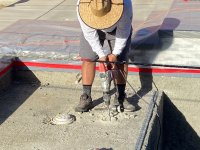Hello, new to the group, so of course I'm hear to learn and ask for advice. We live in Los Angeles & bought our house in 1983 with an existing pool from the 70's. We stripped down to the gunite & resurfaced with new plaster in 1986 and have acid washed twice. We maintain the pool ourselves & use a Kreepy Krauly. We were recently told to replace the water because it was bad (old), it wasn't holding chemicals and in doing so, we discovered hollow spots (they can be heard by tapping or running a hammer edge). The surface doesn't look bad, but it's rough & it's time. I've attached a pic of the empty pool, since you like pics. We're going to use the TFP method moving forward.
Good 'ol fashion white (marble) plaster is our product of choice and new tile. Our pool builder comes higher recommended! However, we're going to do our best to make sure this plaster lasts as long as our previous plaster. I've read that plaster lasts 7-10 years....I can't believe that work has become so shoddy or maybe laws have changed and require the use of less effective material. The PB provides start-up for 7-10 days, that includes vacuuming and water testing.
So we don't know what we don't know.......We'd like to learn what to look out for. They will be stripping out the old plaster down to the gunite. How many coats of plaster should we "see" applied? Will they be applied separately or all together? Are all the layers white? Do we need to make sure steps & corners are applied with a heavier layers? Anything special for the Jacuzzi? I read that so much can go wrong with the workmanship that won't appear until years later. What should we be watching for as they are re-plastering? How are workers cutting corners to get the job done faster? In hopes that the workers will put their best foot forward, I'll give them some cash upon arrival
TIA!!!
Good 'ol fashion white (marble) plaster is our product of choice and new tile. Our pool builder comes higher recommended! However, we're going to do our best to make sure this plaster lasts as long as our previous plaster. I've read that plaster lasts 7-10 years....I can't believe that work has become so shoddy or maybe laws have changed and require the use of less effective material. The PB provides start-up for 7-10 days, that includes vacuuming and water testing.
So we don't know what we don't know.......We'd like to learn what to look out for. They will be stripping out the old plaster down to the gunite. How many coats of plaster should we "see" applied? Will they be applied separately or all together? Are all the layers white? Do we need to make sure steps & corners are applied with a heavier layers? Anything special for the Jacuzzi? I read that so much can go wrong with the workmanship that won't appear until years later. What should we be watching for as they are re-plastering? How are workers cutting corners to get the job done faster? In hopes that the workers will put their best foot forward, I'll give them some cash upon arrival
TIA!!!

Last edited by a moderator:




